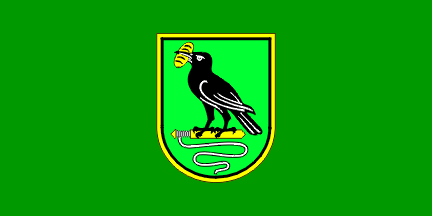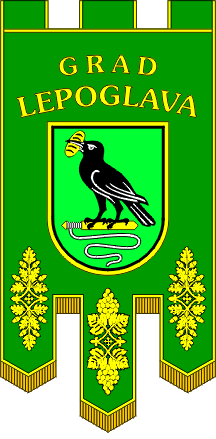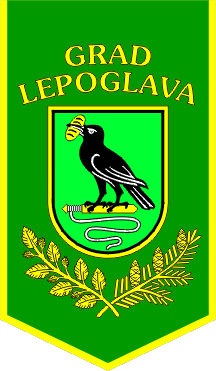
image by Željko Heimer, 18 September 2005

Last modified: 2010-02-19 by dov gutterman
Keywords: varazdin | lepoglava | raven |
Links: FOTW homepage |
search |
disclaimer and copyright |
write us |
mirrors

image by Željko Heimer, 18 September 2005
See also:
Lepoglava is a city in the Varaždin County some 20 km
southwest of Varaždin. 9,000
inhabitanits, half of that number in the city itself. Lepoglava
is probably most well known as a site of a prison (where a number
of important persons were held by regimes of both Yugoslavia in
20th century), but Lepoglava is also a cultural canter with a
Pauline order monastery and is especially famous for the
intricate lacework school. Anyway, a local news magazine
printed a story "Lepoglava dobila službeno heraldicko
znakovlje", Varaždinske vijesti, br. 127, 15.12.2005,
str. 43. describing how on 8 December 2004 the mayor of Lepoglava
ceremoniously presented for the frist time the symbols of the
city. The coat of arms of Lepoglava vert a raven sable
holding a bread in its beak. The raven is symbol of St. Paul the
Hermit who was fed by a raven with bread. St. Paul establsihed
the Pauline order. A raven is also a symbol of royal family of
king Ivaniš Korvin (1495 - 1497), who is remembered in
Lepoglava for rebuilding of the monastery. The flag is
blue with the golden bordered coat of arms.
Željko Heimer, 27 Febuary 2005
In the mean time I received some answer from the city, so I
may correct previous and add some further info: The symbols were
adopted on 8th December 2004. Source: "Lepoglava dobila
službeno heraldicko znakovlje", Varaždinske
vijesti, br. 127, 15.12.2005, str. 43. Info Marija Varovic, Grad
Lepoglava, 9.03.2005.
The coat of arms of Lepoglava vert a raven sable holding a piece
of bread in its beak standing on a lace clapper or with a sting
argent. The raven is symbol of St. Paul the Hermit who was fed by
a raven with bread. St. Paul established the Pauline order whose
important centre Lepoglava is. A raven is also a symbol of royal
family of king Ivaniš Korvin (1495 - 1497), who is
remembered in Lepoglava for rebuilding of the monastery. The
clapper is a tool for the lacework after which Lepoglava is
famous.
The flag is green with the golden bordered coat of arms. (it is
not blue as I first guessed from a rather bad photo I had).
The ceremonial flag is green gonfalon ending triangulary, with
the coat of arms bordered golden with the name of the city aboe
and an valnut and a fir branch below.
Željko Heimer, 10 April 2005
In Latin, a raven is a "corvus" (French,
"corbeau"; Spanish "cuervo"); therefore, the
association of the raven and the Korvin family might not be
coincidental.
Was the famous Matthias I Korvin, King of Hungary from 1458 to
1490, a relative of Ivanis Korvin?
Ivan Sache, 12 April 2005
Here is my translation from Enciklopedija leksikografskog
zavoda, Zagreb, 1968:
"Ivaniš Korvin (Lat. Johannes Corvinus; Wroclav,
Silesia, 1473 - Krapina, 1504), Hereditary Duke of Slavonia, Ban
of Dalmatia and Croatia. Bastard son of king Matijaš Korvin,
grandson of JŠnos Hunyadi. Since Matijaš had no sons in his
marriage, he wanted Ivaniš to inherit his throne, so he was
granting him possessions in Croatia. However, after the death of
Matijaš, it was Vladislav Jagelo (Ladislas Jegielo) who was
elected for the Croatian-Hungarian king. Before the election the
large feudal lords promised to Ivaniš to become the king of
Bosnia, a hereditary duke (vojvoda - dux) of Slavonia, ban of
Croatia and Dalmatia and to keep his possessions. After the
election, Ivaniš was granted only the hereditary dukedom of
Slavonia, but still he was helping to Vladislav in his struggle
against king Maximilian, pretender to the Croato-Hungarian
throen. Ivaniš lead constant struggle against the Turks, and
he was in a feud with Frankapanes who requested from him
possessions taken from them by king Matijaš. Disapointed,
Ivaniš denounced the dukedom. In the heavy times after the
defeat on the Krbava field (1493) he took the dukedom again and
maintained his rule from Bihac and Krapina, fighting the Turks.
Defeated in fights near Knin retreated to Krapina where he soon
died."
The attribute "king Ivaniš" given to him in
Lepoglava connection is, no doubt according to the local legend.
It may well been that the exact title was not quite clear anyway.
Željko Heimer, 12 April 2005
I received the original files of the adopted proposal of the
symbols of Leploglava. The city administration previously sent me
this what I call "Ceremonial Table Flag"
while the files contain the "Ceremonial Flag"
of slightly different design . I presume that the large
ceremonial flag might have been made with three tails, but they
decided that it is too complex for table flags, so they go with
the other design for them. However, the difference in
ornamentatio species strikes me as odd.
Željko Heimer, 18 September 2005
Here is the reference to the decision adopting the symbols:
Odluka o opisu i uporabi grba i zastave Grada Lepoglave,
15.11.2005, Službeni vjesnik Varaždinske županije,
br. 29/2005, 16.11.2005.
Previous date of adoption we had was 8 December 2004, but this is
the date of the first public presentation (use) of the symbols -
they were adopted, as the document above claims, on 15 November
2005.
The article mentioned above clearly states that the design of the
coat of arms and the flag was made by the Heraldic-art d.o.o. of
Rijeka.
The coat of arms and the flag were included in the latest
amendments to the statutes with their full description in the
article 6, where before was standing only that they exist:
Izmjene i dopune Statuta Grada Lepoglave, 6.02.2006,
Službeni vjesnik Varaždinske županije, br. 3/2006,
08.02.2006.
The decision above, just as the statutes of 2006 do not mention
the ceremonial nor the table flags.
Željko Heimer, 30 July 2006
The symbols were designed by the Heralid
Art d.o.o company in Rijeka.
Željko Heimer, 2 November 2007
While the amendments to the statutes of 2006 introduced the
description of the coat of arms and the flag in the statutes, the
new 2009 statutes do not include them, leaving it for a separate
decision (adopted in 2005, as reported).
Source: <www.glasila.hr>.
Željko Heimer, 20 December 2009

image by Željko Heimer, 18 September 2005

image by Željko Heimer, 18 September 2005
vz-le.gif)
image by Željko Heimer, 18 September 2005